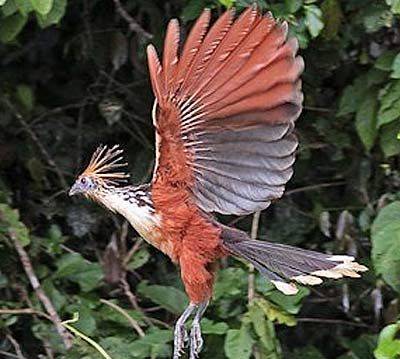
The hoatzin (Opisthocomus hoazin)
Hoatzins are seasonal breeders, breeding during the rainy season, the exact timing of which varies across its range. Hoatzins are gregarious and nest in small colonies, laying two or three eggs in a stick nest in a tree hanging over water in seasonally flooded forests. The chicks, which are fed on regurgitated fermented food, have another odd feature; they have two claws on each wing. Immediately on hatching, they can use these claws, and their oversized feet, to scramble around the tree branches without falling into the water. When predators such as the great black hawk attack a hoatzin nesting colony, the adults fly noisily about, trying to divert the predator's attention, while the chicks move away from the nest and hide among the thickets. If discovered, however, they drop into the water and swim under the surface to escape, then later use their clawed wings to climb back to the safety of the nest. This has inevitably led to comparisons to the fossil bird Archaeopteryx, but the characteristic is rather an autapomorphy, possibly caused by an atavism toward the dinosaurian finger claws, whose developmental genetics ("blueprint") presumably is still in the avian genome. Since Archaeopteryx had three functional claws on each wing, some earlier systematists speculated that the hoatzin was descended from it, because nestling hoatzins have two functional claws on each wing. Modern researchers, however, hypothesize that the young hoatzin's claws are of more recent origin, and may be a secondary adaptation from its frequent need to leave the nest and climb about in dense vines and trees well before it can fly.
Advertisements
24 March 2022
Advertisements



